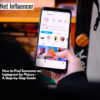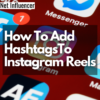Agency
The Investment-Execution Gap: Why Brands Miss The Mark With Creator Marketing Despite Record Spending
As companies pour millions into creator marketing, many continue to fall short of success. Influencity CEO Daniel Sánchez has observed this pattern firsthand while developing campaign management tools used across 70 countries.
Campaign budgets continue to grow, yet performance metrics lag behind. The root cause? Many companies still treat creator partnerships as an add-on rather than a specialized field requiring dedicated expertise and systems.
“It’s good for the industry that brands and agencies see the potential and the return of investment on influencers, but the market is also getting more mature,” Daniel says.
This gap between investment and implementation highlights a significant industry blind spot. While companies that mastered basic social media management now struggle with complex creator collaborations, specialized agencies using professional tools achieve superior campaign results.
Through his experience, Daniel demonstrates how the advancement of the creator economy has surpassed organizational preparedness and outlines the essential components for achieving sustained success in this increasingly professional field.
When Amateur Implementation Costs More
Daniel draws a parallel to social media’s early stages: “Let’s go back 15 years ago when social media was something but wasn’t a critical thing in the marketing strategy when there were not people with a job position like community manager.”
The progression became evident – specialized roles emerged as social platforms gained importance. “Now everybody on social media has a community manager on their team or at least some type of outsourced company or provider.”
This pattern now repeats with creator marketing. “Some years ago, there were no specific roles like influencer marketing specialist or marketing manager,” Daniel explains. “So brands still think that this job can be done by a community manager, which is completely different.”
Daniel outlines the predictable results of this approach: “They utilize influencer marketing where it doesn’t work, and then they believe that influencer marketing doesn’t work for them.” He emphasizes the need for proper infrastructure: “You must create a team. If you don’t have it, you create a team, and it’s a new team… you cannot do it with the people that you have in-house.”
The development process takes time: “Obviously, it will take time because they have to learn how it works and become an industry expert. So it takes time, and you and your team will probably make many mistakes.”
The Agency Advantage
This widespread challenge has influenced Influencity’s development. “We have found a specific niche with agencies,” Daniel reveals. “They’re more professional in the sense that they know more about the market than brands.” This insight guided their tool development, including their campaign proposal system.
“Instead of contacting 100 influencers, I contact 2, 3, 4, 5 talent agencies,” he explains. “They will do all the work for me. They will provide me with their rosters and portfolios, and then I will choose, and then I have to pay one, two, or three agencies instead of paying 100 influencers separately.”
However, this model presents specific challenges: “There can be many misunderstandings or miscommunications because then you have a middleman there at the end of the day. The brand doesn’t speak with the influencer directly or not necessarily.”
Building Professional Systems
Based on platform data and client success patterns, Daniel Sanchez outlines a framework for effective creator marketing operations. “The critical points on the campaign,” he explains, “are how you select those influencers. It’s a matter of many things—tone of voice, audience, and they must help you achieve your goals.”
He identifies three key components for success:
Strategic Long-Term Planning
“First, you have to think this is a long-term strategy. If you think that you will do a one-shot campaign, that won’t work,” Daniel emphasizes. “You must understand that this is a long-term strategy, at least six months.” While specific campaigns can succeed independently, lasting results require sustained commitment and patience.
Defined Goals and Integration
“Before even saying what influencers are good for you or bad, understand your goals,” Daniel insists. “Then, when you have this strategy, long-term study with your goals, you have to realize that this is a component of a bigger strategy. You can do paid promotions and create content from inside your brand. You can do many things, not only influencer marketing.”
Performance Measurement
Daniel provides detailed guidance on measurement strategy: “It depends on the goal. What is very important is not to become crazy and want to track everything and measure everything.”
He offers specific examples: “If you are an e-commerce and your goal is to sell more and increase sales and conversions, you will have to track things like CPM, CPC traffic, that’s kind of the top funnel and then conversions through coupons, discounts or tracking codes… and sales as probably the latest and most important KPI.”
For brands prioritizing awareness over direct sales, different metrics matter: “If you have more brand awareness and visibility, sales probably don’t make sense to track because it’s going to be like a consequence of a bigger strategy. You will probably need to track engagement, views, or CPM. And maybe a share of voice can be a metric.”
Measurement sophistication should align with organizational capability. “Most brands don’t do this calculation properly,” Daniel notes. “If you are doing paid campaigns anywhere, you must first track how much you are paying for a view, a reach, an impact, a like, a comment, any type of interaction. And you have to split or break down all those costs in all the social networks you are doing this kind of paid campaigns.”
Strategic Actions for an Advancing Industry
The creator economy enters a new phase requiring more sophisticated approaches. “We’re seeing a convergence,” Daniel explains, “There’s kind of like a combination between affiliate, UGC, and influencers that has a lot of synergies. Even if they are separated, we will see more strategies combining all three.”
This convergence reshapes how organizations approach creator partnerships. Influencity’s response shows this shift: “We are creating different tools not only in the influencer marketing space but also in social media management and social listening,” Daniel reveals. “We got strategic about what value we’re bringing to our audience. We’re trying to become a hub for social media, influencer marketing and monitoring.”
For companies adapting to these changes, Daniel emphasizes professional expertise: “If you want to go just to the point, hire a team or hire an agency. That’s good because it helps you to learn from them. You can learn how the agency does things.”
He particularly values starting with agency partnerships: “If they try with an agency first, it’s much better because they will realize and learn how influencer marketing is done.”
Agencies face their own adaptation requirements. “The collaborations between brands and influencers are going through talent agencies more and more,” Daniel notes. “Instead of contacting 100 influencers, brands contact 2-3 talent agencies. They will do all the work and provide their rosters and portfolio.” This creates new considerations: “You have to make sure that you are going to be able to provide value to this company because if not, then you’re wasting their time.”
Technology platforms must support increasingly complex workflows. “We are developing many features in terms of product,” Daniel explains. “There are things like how talent management agencies can manage their roster and how we help them get more brand collaborations with a specific influencer they represent.” He emphasizes specialized tool requirements: “A talent agency has different challenges than an influencer marketing agency and different challenges than a PR agency. But we are creating different tools around all these types of roles.”
Measurement becomes crucial in this professional phase. “I recommend tracking earned media value, but properly,” Daniel insists. “If an influencer gets 1,000 likes and you know that in your paid collaboration, on average, you are paying $1 per each like, then that influencer has generated earned media value of $1,000 for you. You can compare these two different types of campaigns.”
Success requires organizations to professionalize while maintaining adaptability. “The industry changed completely from what you expect,” Daniel observes. “What worked yesterday might not work tomorrow.” Success in this phase demands both specialized expertise and rapid adaptation as the creator economy advances.
The investment-execution gap presents both challenges and opportunities. As Daniel concludes: “If they do this properly, then I’m sure that it will work.”





















